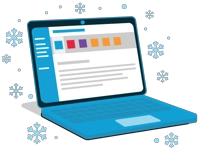In compliance with the Canada Anti-Spam Legislation (CASL), here's when and how we communicate with you electronically.
We send you regular emails if...
- You gave us your name and email address in the newsletter sign-up form on our website;
- You checked the box to get added to our mailing list when requesting a trial; or
- You bought software from us;
- You dropped your business card in our mailing list sign-up "fish bowl" at a trade show or conference.
We occasionally send one-time emails to...
- The attendees of our webinars or seminars, to provide links to videos or additional training materials.
- Members of mailing lists shared with us from other organizations who have received your opt-in consent. Usually, this is from other conferences or trade shows, such as when we join the Alan Salmon tour in the fall.
In both cases, these lists are never merged with our regular newsletter list.
We never make robocalls or send text messages
We do not use automated phone systems that leave messages, nor do we send texts to mobile phones.
You always have a choice
No matter how you join our list, at the bottom of all our emails, you will find a clear, easy way to unsubscribe. Simply click the link.
If you're a current customer, keep in mind you will no longer receive email about software updates. You will of course still see release announcements on our blog and the automatic update notifications in our product.
That's the short answer. For those who prefer a more detailed response to the word of the Act, read on...
Our long answer
TaxCycle is compliant with CASL. The salient parts of the CASL act and commentary on TaxCycle adherence appear below.
Full text of CASL Act can be found here: http://laws-lois.justice.gc.ca/eng/acts/E-1.6/FullText.html
Section 1.1
“Electronic message” means a message sent by any means of telecommunication, including a text, sound, voice or image message.
“Electronic address” means an address used in connection with the transmission of an electronic message to
(a) an electronic mail account;
(b) an instant messaging account;
(c) a telephone account; or
(d) any similar account.
As part of engaging in commercial activity, TaxCycle regularly sends electronic communications to electronic addresses of both potential clients and existing clients.
TaxCycle currently only sends Electronic Messages in the form of email, which can include text, graphics and links to both external websites as well as www.taxcycle.com.
Of the types of electronic addresses listed in the act, TaxCycle currently only sends to electronic mail accounts.
TaxCycle does not use automated phone systems that leave messages, nor does TaxCycle send texts to mobile phones.
Section 1.2
A commercial electronic message is an electronic message that, having regard to the content of the message, the hyperlinks in the message to content on a website or other database, or the contact information contained in the message, it would be reasonable to conclude has as its purpose, or one of its purposes, to encourage participation in a commercial activity, including an electronic message that
(a) offers to purchase, sell, barter or lease a product, goods, a service, land or an interest or right in land;
(b) offers to provide a business, investment or gaming opportunity;
(c) advertises or promotes anything referred to in paragraph (a) or (b); or
(d) promotes a person, including the public image of a person, as being a person who does anything referred to in any of paragraphs (a) to (c), or who intends to do so.
TaxCycle regularly sends email to two databases:
- Existing clients are sent educational emails, reminders for software releases as well as information about their account and our work with them, in addition to commercial messages.
- Prospects receive a monthly newsletter, which is a combination of education as well as offers for further information about software releases and purchase messages.
TaxCycle also sends emails to people in response to requests for information, on a one-time basis:
- People who attend a webinar get an email with information the day after the webinar
- People who attend a seminar may receive an email after with follow-up information.
- Occasionally, to people who attend conferences and seminars (for example the Alan Salmon tour). In these cases the list is provided by the other organization who has prior opt-in permission.
Section 1.3
(3) An electronic message that contains a request for consent to send a message described in subsection (2) is also considered to be a commercial electronic message.
Since inception, TaxCycle has not engaged in sending unsolicited requests to electronic addresses for any reason.
Section 6.1
It is prohibited to send or cause or permit to be sent to an electronic address a commercial electronic message unless
(a) the person to whom the message is sent has consented to receiving it, whether the consent is express or implied; and
(b) the message complies with subsection (2).
There are four methods that TaxCycle uses to gain consent to send electronic messages:
- When the person explicitly subscribes to the mailing list as shown below on the www.taxcycle.com homepage. An email is immediately sent to the recipient asking for confirmation of consent by clicking on a link in the email (“double opt-in”).
- If a person requests a trial download from TaxCycle, they are given the opportunity to receive our newsletter by explicitly “checking” an option on the request form, as shown below, signalling “Yes," they wish to receive the TaxCycle newsletter (clearly identified). See below. If the person does not check “Yes,” they are not added to the monthly newsletter mailing list. However, information about the use of the trial will be emailed to the person as part of the service of providing our software. This is in accordance with the CRTC’s Guidelines on the interpretation of the Electronic Commerce Protection Regulations: http://www.crtc.gc.ca/eng/archive/2012/2012-548.htm
- If a person buys our software, they receive electronic communications as part of our service / subscription.
- TaxCycle also obtains email addresses at “fish bowls” at tradeshows. It is clearly identified that the business card information will be added to our prospect database.
Since TaxCycle incorporated, the above 4 practices have been followed, in contemplation of the introduction of the Canada Anti-Spam Law (CASL).
Section 6.2
(2) The message must be in a form that conforms to the prescribed requirements and must
(a) set out prescribed information that identifies the person (company) who sent the message and the person (company) — if different — on whose behalf it is sent;
(b) set out information enabling the person to whom the message is sent to readily contact one of the persons referred to in paragraph (a); and
(c) set out an unsubscribe mechanism in accordance with subsection 11(1).
TaxCycle clearly identifies itself as the sender of both client account emails as well as newsletters. TaxCycle includes all pertinent contact information in emails. TaxCycle includes unsubscribe links in all it’s emails.
TaxCycle uses MailChimp.com as its mail service. MailChimp is a leading web-based email marketing service, known as a “bulk mailer.” Bulk mailers are required by law to include an unsubscribe link in every email.
The unsubscribe mechanism is effectively immediately, well within the 10 day prescribed time limit in section 11.4(b)
Section 6.6
Paragraph (1)(a) does not apply to a commercial electronic message that solely
(a) provides a quote or estimate for the supply of a product, goods, a service, land or an interest or right in land, if the quote or estimate was requested by the person to whom the message is sent;
(b) facilitates, completes or confirms a commercial transaction that the person to whom the message is sent previously agreed to enter into with the person who sent the message or the person — if different — on whose behalf it is sent;
(c) provides warranty information, product recall information or safety or security information about a product, goods or a service that the person to whom the message is sent uses, has used or has purchased;
(d) provides notification of factual information about
(i) the ongoing use or ongoing purchase by the person to whom the message is sent of a product, goods or a service offered under a subscription, membership, account, loan or similar relationship by the person who sent the message or the person — if different — on whose behalf it is sent, or
(ii) the ongoing subscription, membership, account, loan or similar relationship of the person to whom the message is sent;
(e) provides information directly related to an employment relationship or related benefit plan in which the person to whom the message is sent is currently involved, is currently participating or is currently enrolled;
(f) delivers a product, goods or a service, including product updates or upgrades, that the person to whom the message is sent is entitled to receive under the terms of a transaction that they have previously entered into with the person who sent the message or the person — if different — on whose behalf it is sent;
To be clear:
- TaxCycle provides price quotes and estimates by email as per section 6.6(a).
- TaxCycle provides information and software instructions by email as per section 6.6(c).
- TaxCycle provides emails to existing clients as per sections 6.6 (d), in the form of an annual one time purchase or monthly subscription.
- TaxCycle does have an employment relationship with its mailing list members per 6.6(e).
… all of which is normal operations under CASL section 6.6, and complies with the law.



